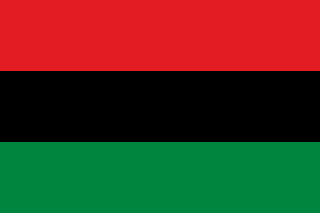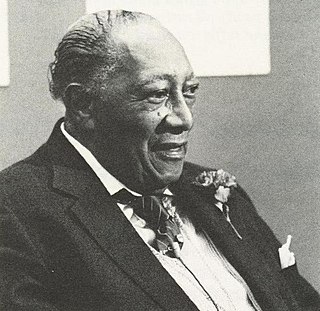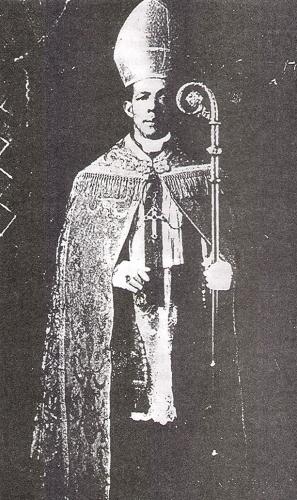
Marcus Mosiah Garvey Jr. was a Jamaican political activist. He was the founder and first President-General of the Universal Negro Improvement Association and African Communities League, through which he declared himself Provisional President of Africa. Ideologically a black nationalist and Pan-Africanist, his ideas came to be known as Garveyism.

The Pan-African flag is a tri-color flag consisting of three equal horizontal bands of red, black, and green. The Universal Negro Improvement Association and African Communities League (UNIA-ACL) formally adopted it on August 13, 1920, in Article 39 of the Declaration of the Rights of the Negro Peoples of the World, during its month-long convention at Madison Square Garden in New York City. Variations of the flag can and have been used in various countries and territories in the Americas to represent Garveyist ideologies.

The Universal Negro Improvement Association and African Communities League (UNIA-ACL) is a black nationalist fraternal organization founded by Marcus Garvey, a Jamaican immigrant to the United States, and Amy Ashwood Garvey. The Pan-African organization enjoyed its greatest strength in the 1920s, and was influential prior to Garvey's deportation to Jamaica in 1927. After that its prestige and influence declined, but it had a strong influence on African-American history and development. The UNIA was said to be "unquestionably, the most influential anticolonial organization in Jamaica prior to 1938," according to Honor Ford-Smith.

Garveyism is an aspect of black nationalism that refers to the economic, racial and political policies of UNIA-ACL founder Marcus Garvey. The ideology of Garveyism centers on the unification and empowerment of African-descended men, women and children under the banner of their collective African descent, and the repatriation of the descendants of enslaved Africans and profits to the African continent.

James Augustus Van Der Zee was an American photographer best known for his portraits of black New Yorkers. He was a leading figure in the Harlem Renaissance. Aside from the artistic merits of his work, Van Der Zee produced the most comprehensive documentation of the period. Among his most famous subjects during this time were Marcus Garvey, Bill "Bojangles" Robinson and Countee Cullen.

Henrietta Vinton Davis was an elocutionist, dramatist, and impersonator. In addition to being "the premier actress of all nineteenth-century black performers on the dramatic stage", Davis was proclaimed by Marcus Garvey to be the "greatest woman of the Negro race today".

Tony Martin was a Trinidad and Tobago-born scholar of Africana Studies. From 1973 to 2007 he worked at Wellesley College in Wellesley, Massachusetts, and over the course of his career published more than ten books and a range of scholarly articles.

Amy Euphemia Jacques Garvey was a Jamaican-born journalist and activist. She was the second wife of Marcus Garvey. She was one of the pioneering female Black journalists and publishers of the 20th century.
William Henry Ferris was an author, minister, and scholar.

"New Negro" is a term popularized during the Harlem Renaissance implying a more outspoken advocacy of dignity and a refusal to submit quietly to the practices and laws of Jim Crow racial segregation. The term "New Negro" was made popular by Alain LeRoy Locke in his anthology The New Negro.
Amy Ashwood Garvey was a Jamaican Pan-Africanist activist. She was a director of the Black Star Line Steamship Corporation, and along with her former husband Marcus Garvey she founded the Negro World newspaper.

George Alexander McGuire was the founder of the African Orthodox Church, and a prominent member of Marcus Garvey's Universal Negro Improvement Association (UNIA).

Emory J. Tolbert (1946-2022) was an American historian, educator, and activist. His scholarship centers on Marcus Garvey and Garveyism, as well as wider aspects of African American history.
Carlos A. Cooks was a politician from Dominican Republic.

Black Cross Nurses is an international organization of nurses which was founded in 1920, based upon the model of the Red Cross. The organization was the women's auxiliary of the Universal Negro Improvement Association and African Communities League and was established to provide health services and education to people of African descent.
Wilfred Adolphus Domingo was a Jamaican activist and journalist who became the youngest editor of Marcus Garvey's newspaper, the Negro World. As an activist and writer, Domingo travelled to the United States advocating for Jamaican sovereignty as a leader of the African Blood Brotherhood and the Harlem branch of the Socialist Party.

Maymie de Mena was an American-born activist who became one of the highest-ranking officers in the Universal Negro Improvement Association (UNIA). She has been credited with keeping the organization alive after Marcus Garvey's conviction for mail fraud and deportation from the United States.
Dorothy Randolph Peterson was an American teacher and actress who played an important role in the Harlem Renaissance through her efforts to promote and preserve the achievements of African-American artists.
Mason Alexander Hargrave was an organizer in the African-American community. He spent his later years in Cleveland, Ohio, in a leadership role at the United Negro Improvement Association (UNIA). He was involved in promoting use of the red, black, and green Pan-African flag and had it flown over Cleveland City Hall in 1974. He was an acolyte of Marcus Garvey and wrote a letter of "testimony" to U.S. Representative John Conyers in 1987 objecting to mail fraud charges against Garvey.












